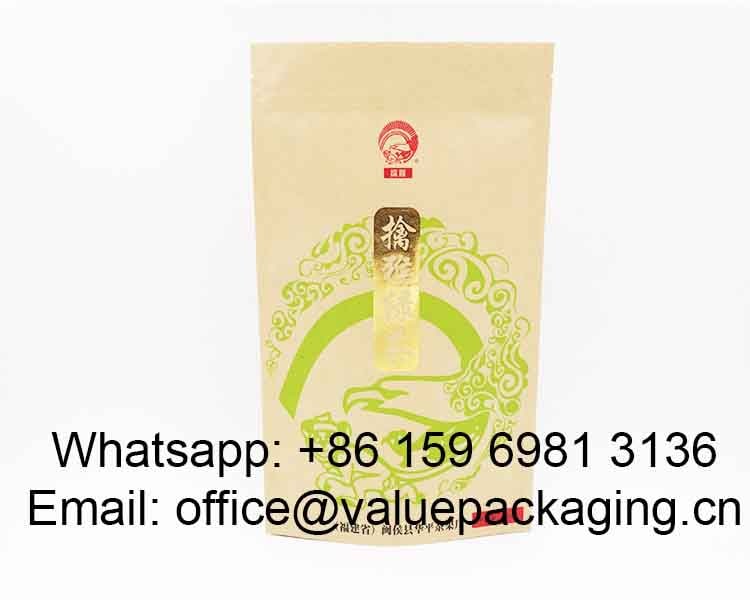
As in the picture above, it is a paper bag intended for 250 grams of green tea. The tea packed in paper bags is very common in the market. Compared to the flat pouch, Doypack is achieved with the bottom part gusseted into the pouch, which can be able to hold more product. It can also better display the products.
This customer seeks us out to plan a fantastic paper pouch for his higher-level tea product. We utilise kraft paper to create an eco-friendly package for this customer.
There is a high requirement for the packages to preserve green tea. Based on a flexible combination of various polymer film materials, the foil materials can provide excellent barrier properties against sunlight, moisture, and oxygen.
Located in Qingdao, China, we are a well-known flexible converter that uses the best film materials available in the market, as stated below.
- fossil chemical polymer films
- Aluminum foil metal sheet
- vacuum metalized film materials
- Ceramic film substrates
- plant-based biopolymer materials
- biodegradable film materials
- compostable substrate films
- Fully recyclable substrate films
Ok, next I will give details of the packaging materials of this 50-gram green tea paper bag pouch.
Laminated Foil Materials

From the above graphic, you can learn that the material is made of 4 layers. Matte BOPP film works as the outside print layer, with aluminum foil working as the main barrier layer. Kraft paper and VMPET film working as the middle supportive and barrier layer, and finally, the LDPE film working as the inner sealing layer. Generally, we describe the foil structure as Matte BOPP/Kraft Paper/VMPET/LDPE.
- With a matte finish effect on the outside, matte BOPP Filmworks as the outside print layer can improve the visual effect and add a fashionable touch to the packaging.
- Kraft paper is one of the most commonly used materials to increase the eco-friendliness and sustainability of the packages. Kraft paper in natural color with a weight of 70gsm works as the intermediate layer. It is of good stiffness and a supportive layer.
- VMPET film, with the most common thickness of 12 microns, works as the main barrier layer in this foil laminate, which can well protect green tea from moisture vapor and oxygen.
- LDPE film, with thickness adjustable against the requirements of the final package, works as the inner sealing layer.
Matte BOPP Film

Matte BOPP, or matte biaxially oriented polypropylene, is a polymer film with a matte finish that absorbs light instead of reflecting it. With a matte finish effect on the outside, matte BOPP film is widely used to improve visual effects and add a fashionable touch to the packaging.
It’s made up of multiple layers, including a polypropylene core and tie layers, and is often co-extruded with a skin copolymer layer on one or both sides.
The film is prepared through extrusion and biaxial orientation and can be made using either the tubular or tenter frame process.
Kraft Paper Film
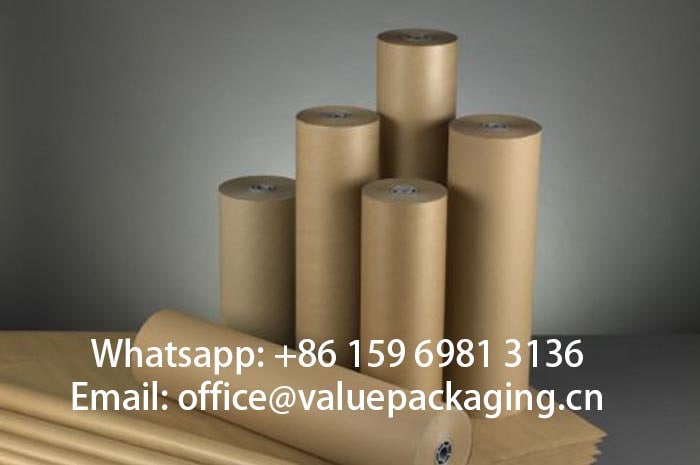
Brown kraft paper is a heavy-duty, durable, and tear-resistant paper that is usually brown in color and made from wood pulp. It’s known for its natural wood fibers and textures and has an earthy, rugged look. Kraft paper is versatile and can be used for a variety of packaging purposes, such as shipping, wrapping, corrugated boxes, carton boxes, and flexible packaging.
VMPET Film
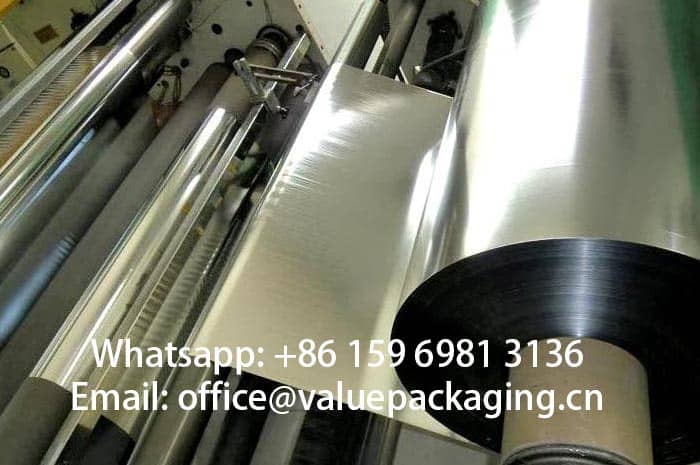
VMPET12, means vacuum metallized polyester film with thickness 12 microns (equals to 0.48 gauge), is the most common used aluminum-metallized film in the flexible packaging field. The VMPET layer is a key component for barrier performance. It offers an effective barrier against oxygen, moisture, and light. Oxygen can cause oxidation of the tea, leading to rancidity and a loss of flavor. Moisture can make the tea soggy and affect their texture. Light can also degrade the quality of the tea over time. The VMPET layer, in combination with the other layers, significantly reduces the permeation of these harmful elements, thereby extending the shelf life of the tea and maintaining its quality and taste. Be made your green tea products to be well protected from the roaster warehouse to the consumer’s hand in a fine way.
LDPE Film
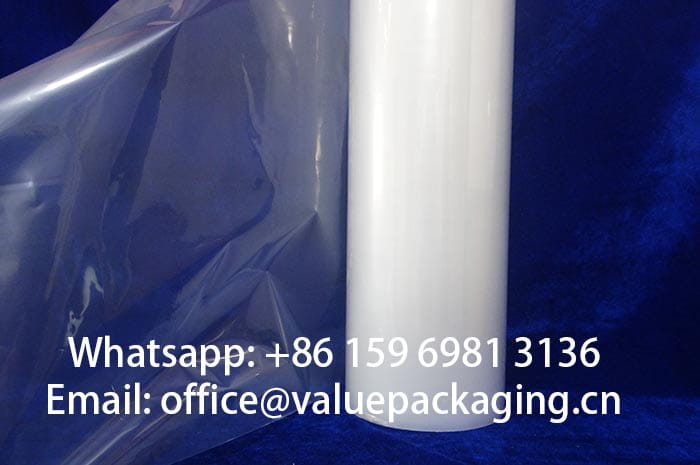
LDPE, means low density polyethylene film, it is environmentally friendly, low-cost, and low-energy. It is the most used inner sealing layer for the green tea bag. It is able to provide enough sealing strength and airtight property for the final packages.
So, how does this foil structure perform when it is intended for green tea paper standup bag? Will it break during the transit?\
Great Standup Effect
Upon our experience, with the supportive middle layer of Kraft paper/VMPET film, this fourfold foil laminate is stiff enough to create a good standup effect for the package up to 1000g. When tea is filled into this doypack, the expanded bottom will provide a large foundation to support the pouch and stand well on the shelf. You can see the fat bottom in the below video.
Excellent Airtight Property for Zipperlock
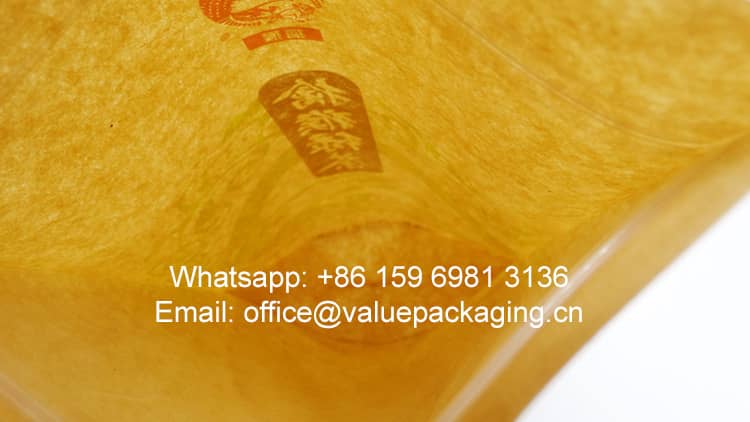
This single-track plastic zipper is applied onto the kraft paper doypack. The zipper will be tightly sealed with the inner LDPE film of the paper pouch. It enables the package to be repeatedly opened and closed with great airtight properties. The green tea can be kept fresh for a long time after being opened.
Serious measures are taken in our QC work to check the airtight properties for the inner zipper, and you are advised to have a further understanding of this test progress through the video below.
Great Mechanical Property
The paper package will protect green tea in filling, transit, and distribution. Under the emergency circumstances of unexpected shock in delivery or packages falling off the goods shelf, the paper package will never be allowed to break.
This reinforced laminated foil is achieved with great mechanical strength, with some standard items as below.
- Tensile Strength
- Sealing Strength
- Anti-puncture Strength
- Burst Impact Strength
- Anti-pressure Property
The above tests are performed against each order based on customer requirements, and you may check the exact values of this foil material in the Technical Date Sheet part of this post.
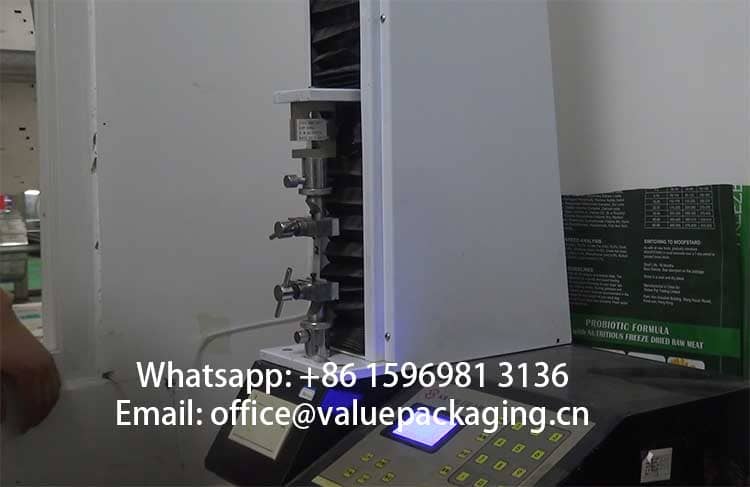
In our daily QC work, there is a more reliable method to check if the bag strength is enough to meet the final requirements of various customers. We perform a drop test against each order, of course, the standard for this drop test should be decided against customer needs.
Here, we are going to fill 250 grams of green tea into this kraft paper foil pouch, perform drops 5 times, and check if there is any breakage for the package.
Drop Test #
Barrier Performance
Usually, the barrier performance of a multi-material laminate is evaluated by WVTR (short for water vapor transmission rate) and OTR (Oxygen Transmission Rate). The below table shows the typical value of the WVTR and OTR of the most common substrate films in flexible packaging.
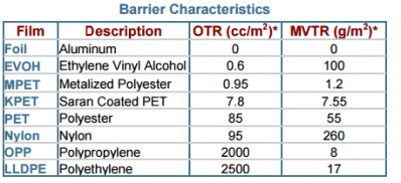
Based on our experience, MatteBOPP/Kraft paper/VMPET/LDPE foil laminate will be able to meet most of the requirements for green tea. WVTR (short for water vapor transmission rate) and OTR (Oxygen Transmission Rate) are evaluated for this laminated foil, with typical values listed in the below table.
| Item | Standard | Unit | Typical Value |
| Water Vapor Transimission Rate | ASTM E 96 | g/m2/24hr | 0.85 |
| Oxygen Transmission Rate | ASTM D 372-99 | cc/m2/24hr | 1.2 |
Technical Data Sheet of 250g green tea bag
Here, we attach the specification sheet of this 250-gram green tea bag based on foil laminate Matte BOPP18/Kraft Paper 70gsm/VMPET12/LDPE70.
More tests are included in this specification sheet with items available listed as below.
- Yield (grams per square meter)
- Tensile Strength (Mpa)
- Elongation Rate (%)
- Coefficient of friction, short as COF
- Solvents Left (mg/m2 )
- Sealing Strength (N/15mm)
- Sealing Conditions
- Bond Strength (N/15mm)
- Burst Strength (J)
- Anti-Puncture ability (N)
- Drop Test Ability (cm)
- Anti-pressure ability (kgs)
- Water Vapor Transmission Rate (g/m2/24hr)
- Oxygen Transmission Rate (cc/m2/24hr)
Learn more about this foil laminate in our company website.
More Sustainable Materials Options
In recent years, along with the increasing burden of fossil-chemical polymer materials discarded into our environment, there has been an increasing focus on using more sustainable materials. there is an unprecedented demand for sustainable packages which leads to a more eco-friendly activity of the business. Upon the recent investigation of the nut market, more and more consumers are more likely to purchase a product that acts toward environmental sustainability.
Compostable Packaging Materials
The compostable packages are based on plant-based fibers like cellulose, or bio-mass like corn starch, cassava, or sugarcane. The resins derived from these resources are usually named bio-polymer, which can break down into inorganic elements under the functions of algae, bacteria, and other microorganisms.
We have developed several compostable foil materials that can be intended for roasted sunflower seeds, with the list below.
- Cellulose/Metallized Cellulose/PLA+PBAT Film
- Metallized Paper/Cellulose/VMPET/PLA+PBAT Film
- Kraft Paper/Metallized Cellulose/PLA+PBAT Film
Fully Recyclable Mono Materials
Compared with the high cost of compostable foil materials, fully recyclable materials sachets, and rolls are flooding the market for lightweight product packages in the market at much lower prices.
Along with the improvement of barrier performance of PE film materials, their foil laminate can be enabled with a fine property to keep the sunflower seeds from moisture. A layer of PVA coating is applied over the surface of LDPE and HDPE film to enhance the moisture barrier. EVOH can be included in the biaxially orientated film, which is usually called BOPE in the flexible packaging industry, to largely improve the oxygen barrier performance.
Tea in Plastic Sachet #
Nowadays, we have developed some bags based on single resin film materials, that can be found in good application for green tea. We will give a further analysis in future posts.
That all. Just reach us if you have any questions. Have a good time!

